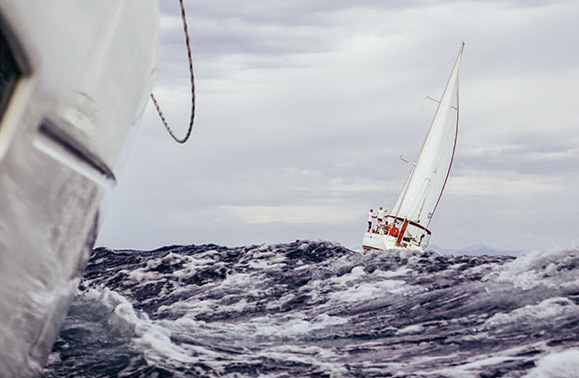Sailing in heavy weather can be daunting for new or inexperienced sailors, so training and preparation is key. Below you can find a definition of heavy weather sailing, followed by a handful of tips and techniques. If you wish to gain confidence, then we recommend taking our Heavy Weather Sailing weekend training course.
What is considered heavy weather sailing?
There is no absolute definition of heavy weather sailing. Instead, heavy weather sailing is considered to be rough weather conditions at sea that are challenging or dangerous for the vessel and its crew. Heavy weather sailing tends to be characterised by high winds, large waves, and other adverse weather conditions that can make navigation and control of the boat difficult.
In many cases heavy weather sailing could be where the wind speed is greater than 20 knots, and with waves higher than 6 feet. At these levels, the sea can become rough and unpredictable, and so can increase the danger to the boat and crew significantly. But to summarise, heavy weather is ANY sailing condition that means you find control of the vessel challenging.
Preparing for heavy weather sailing
Preparing for heavy weather sailing isn’t just about making sure you’ve checked the forecast and have prepared your boat. There’s also mental and physical preparation to consider if the sea is going to be extremely rough. Here is some heavy weather sailing preparation advice, followed by tips.
1. Boat preparation
If rough and heavy weather sailing is forecast, then make sure you perform maintenance checks on your boat including checks that all sails, rigging, and hardware are in good condition and properly secured.

Reduce sail early. Either reef or get the try sail and storm jib up. Don’t wait until it’s too late to send people out of the cockpit.
Heavy weather sailing can result in things being thrown about, so stow away any loose items below deck and secure items that can’t be stowed. This will prevent them from becoming dangerous projectiles. Also check bilge pumps are working ok, an hatches and ports are closed.
2. Crew readiness
Ensure that all crew are ready and aware of forecast heavy weather sailing, including wearing appropriate clothing and gear, such as non-slip footwear, and personal flotation devices (PFDs). You should also brief any inexperienced crew on what to do in case of an emergency. Emergencies can include “man overboard”, or a capsize.
You may also consider assigning specific roles and responsibilities to each crew member when sailing in heavy weather. This means everyone know what is expected of them in heavy weather sailing. We outline best heavy weather sailing techniques and practices in our weekend course.
3. Safety gear and procedures
As well as personal flotation devices, there is other gear to consider in heavy weather sailing including harnesses, working VHF radio, and possibly a satellite phone in case of an emergency.
Heavy weather sailing tips
On our weekend course you will learn how to sail in heavy weather, but here are some quick tips to get you started. In the course, you will learn how to do all of these heavy weather sailing techniques and much more.
1. Sail reduction strategies
When sailing in heavy weather, reducing your sail area can mean you have better control over the boat in high winds. Sail reduction strategies include reefing, furling, and changing to smaller sails.
2. Helming during heavy weather sailing
Steering a course that keeps the boat in a safe and stable position and maintaining control can be hard and scary for novices. Proper helming techniques in heavy weather sailing include steering downwind or upwind, depending on the rough weather conditions. You should never turn the boat broadside to the waves as you can lose control.

3. Sea anchors and drogues
Drogues will help to slow down the boat and keep it pointed into the wind and waves. They can be deployed in addition to anchors in heavy weather sailing.
We’ve just scratched the surface here with how to sail in heavy weather. We would encourage you to come on our weekend instruction course where you will learn the ropes. Literally.
The post Heavy Weather Sailing Tips & Techniques appeared first on Sailing Blog.
